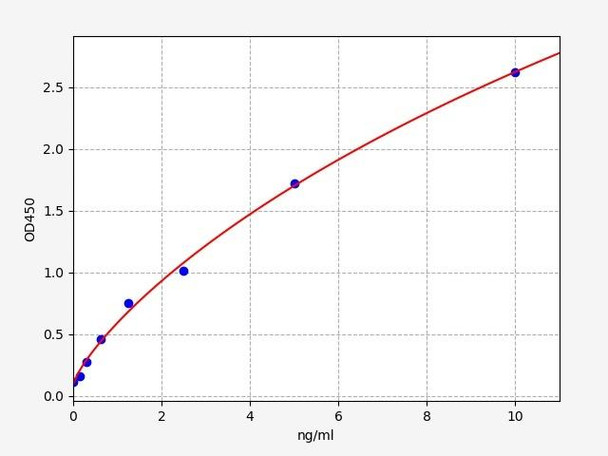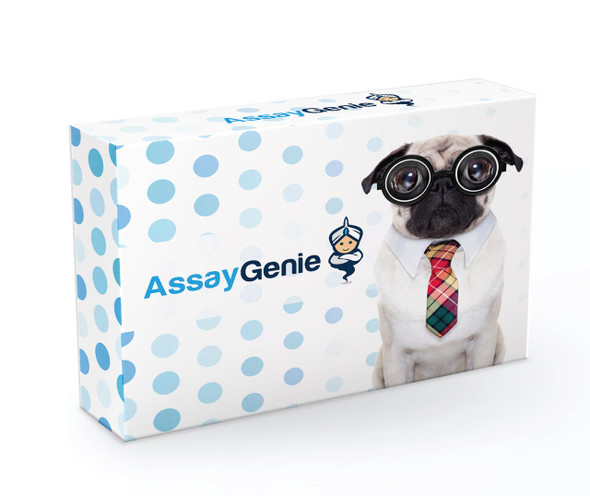Human Mucin-1 / MUC1 ELISA Kit (HUFI00324)
- SKU:
- HUFI00324
- Product Type:
- ELISA Kit
- Size:
- 96 Assays
- Uniprot:
- P15941
- Sensitivity:
- 9.375pg/ml
- Range:
- 15.625-1000pg/ml(1ng/ml=150uIU/ml)
- ELISA Type:
- Sandwich
- Synonyms:
- MUC-1, CD227, Episialin, H23AG, KL-6, Mucin-1, PEM, PEMT, Breast carcinoma-associated antigen DF3, Carcinoma-associated mucin, CD227, CD227 antigen, DF3 antigen, EMA, episialin, H23 antigen, H23AG, KL-6, MAM6, MUC1, ZD, mucin 1, cell surface associat
- Reactivity:
- Human
- Research Area:
- Cell Biology
Description
Human Mucin-1/MUC1 ELISA Kit
The Human Mucin 1 (MUC1) ELISA Kit is a reliable and sensitive tool for the measurement of MUC1 levels in human samples including serum, plasma, and cell culture supernatants. This kit provides accurate and reproducible results, making it suitable for a variety of research applications.MUC1 is a glycoprotein that is overexpressed in various types of cancers, including breast, lung, and pancreatic cancer. It plays a critical role in tumor progression and metastasis, making it a valuable biomarker for cancer research and therapeutic development.
By using the Human MUC1 ELISA Kit, researchers can effectively study the role of MUC1 in cancer development and progression, as well as explore its potential as a target for novel cancer therapies. This kit offers high specificity and sensitivity, ensuring precise measurements of MUC1 levels in human samples.
| Product Name: | Human Mucin-1 / MUC1 ELISA Kit |
| Product Code: | HUFI00324 |
| Size: | 96 Assays |
| Alias: | MUC-1, CD227, Episialin, H23AG, KL-6, Mucin-1, PEM, PEMT, Breast carcinoma-associated antigen DF3, Carcinoma-associated mucin, CD227, CD227 antigen, DF3 antigen, EMA, episialin, H23 antigen, H23AG, KL-6, MAM6, MUC1, ZD, mucin 1, cell surface associated, mucin 1, transmembrane, mucin-1, Peanut-reactive urinary mucin, PEMMUC-1, SEC, PEMT, Polymorphic epithelial mucin, PUMMUC-1, X, tumor associated epithelial mucin, Tumor-associated epithelial membrane antigen, Tumor-associated mucin |
| Detection method: | Sandwich ELISA, Double Antibody |
| Application: | This immunoassay kit allows for the in vitro quantitative determination of Human MUC-1 concentrations in serum plasma and other biological fluids. |
| Sensitivity: | 9.375pg/ml |
| Range: | 15.625-1000pg/ml(1ng/ml=150uIU/ml) |
| Storage: | 4°C for 6 months |
| Note: | For Research Use Only |
| Recovery: | Matrices listed below were spiked with certain level of Human MUC-1 and the recovery rates were calculated by comparing the measured value to the expected amount of Human MUC-1 in samples. | ||||||||||||||||
| |||||||||||||||||
| Linearity: | The linearity of the kit was assayed by testing samples spiked with appropriate concentration of Human MUC-1 and their serial dilutions. The results were demonstrated by the percentage of calculated concentration to the expected. | ||||||||||||||||
| |||||||||||||||||
| CV(%): | Intra-Assay: CV<8% Inter-Assay: CV<10% |
| Component | Quantity | Storage |
| ELISA Microplate (Dismountable) | 8×12 strips | 4°C for 6 months |
| Lyophilized Standard | 2 | 4°C/-20°C |
| Sample/Standard Dilution Buffer | 20ml | 4°C |
| Biotin-labeled Antibody(Concentrated) | 120ul | 4°C (Protect from light) |
| Antibody Dilution Buffer | 10ml | 4°C |
| HRP-Streptavidin Conjugate(SABC) | 120ul | 4°C (Protect from light) |
| SABC Dilution Buffer | 10ml | 4°C |
| TMB Substrate | 10ml | 4°C (Protect from light) |
| Stop Solution | 10ml | 4°C |
| Wash Buffer(25X) | 30ml | 4°C |
| Plate Sealer | 5 | - |
Other materials and equipment required:
- Microplate reader with 450 nm wavelength filter
- Multichannel Pipette, Pipette, microcentrifuge tubes and disposable pipette tips
- Incubator
- Deionized or distilled water
- Absorbent paper
- Buffer resevoir
| Uniprot | P15941 |
| UniProt Protein Function: | MUC1: a large cell surface glycoprotein expressed by most glandular and ductal epithelial cells and some hematopoietic cell lineages. Plays a role in adhesion and cell-cell interactions, metastasis and signaling. May provide a protective layer on epithelial surfaces. Direct or indirect interaction with actin cytoskeleton. Its cytoplasmic tail (MUC1CT) is involved in several signaling pathways, including those involving Ras, beta-catenin, p120 catenin, p53 and estrogen receptor alpha. MUC1CT also forms complexes with transcription factors, and then translocates to the nucleus by an unknown mechanism, where it is believed to influence the transcription of their target genes. MUC1CT has also been proposed to localize to mitochondrial membranes under conditions of genotoxic stress, where it attenuates the apoptotic pathway in response and confers resistance to apoptosis-inducing drugs. Aberrantly glycosylated forms expressed in human epithelial tumors, such as breast or ovarian cancer and also in non-epithelial tumor cells. Nine alternatively spliced isoforms have been described. Isoforms 5 and 9 are secreted. Isoform 7, expressed only in tumor cells, is a receptor and binds the secreted isoform 5. The binding induces the phosphorylation of the isoform 7, alters cellular morphology and initiates cell signaling. Can bind to GRB2 adapter protein. |
| UniProt Protein Details: | Protein type:Nuclear receptor co-regulator; Motility/polarity/chemotaxis; Actin-binding; Membrane protein, integral; Tumor suppressor; Cell adhesion Chromosomal Location of Human Ortholog: 1q21 Cellular Component: extracellular space; cell surface; integral to plasma membrane; Golgi lumen; cytoplasm; nuclear chromatin; apical plasma membrane; vesicle Molecular Function:protein binding; p53 binding; transcription cofactor activity Biological Process: protein amino acid O-linked glycosylation; DNA damage response, signal transduction by p53 class mediator resulting in transcription of p21 class mediator; cellular protein metabolic process; regulation of transcription from RNA polymerase II promoter in response to stress; O-glycan processing; post-translational protein modification; DNA damage response, signal transduction by p53 class mediator resulting in cell cycle arrest Disease: Medullary Cystic Kidney Disease 1 |
| NCBI Summary: | This gene encodes a membrane-bound protein that is a member of the mucin family. Mucins are O-glycosylated proteins that play an essential role in forming protective mucous barriers on epithelial surfaces. These proteins also play a role in intracellular signaling. This protein is expressed on the apical surface of epithelial cells that line the mucosal surfaces of many different tissues including lung, breast stomach and pancreas. This protein is proteolytically cleaved into alpha and beta subunits that form a heterodimeric complex. The N-terminal alpha subunit functions in cell-adhesion and the C-terminal beta subunit is involved in cell signaling. Overexpression, aberrant intracellular localization, and changes in glycosylation of this protein have been associated with carcinomas. This gene is known to contain a highly polymorphic variable number tandem repeats (VNTR) domain. Alternate splicing results in multiple transcript variants.[provided by RefSeq, Feb 2011] |
| UniProt Code: | P15941 |
| NCBI GenInfo Identifier: | 296439295 |
| NCBI Gene ID: | 4582 |
| NCBI Accession: | P15941.3 |
| UniProt Secondary Accession: | P15941,P13931, P15942, P17626, A5YRV1, A6ZID9, A6ZIE0 B1AVQ8, B1AVR0, B6ECA1, E7ESE5, E7EUG9, |
| UniProt Related Accession: | P15941 |
| Molecular Weight: | |
| NCBI Full Name: | Mucin-1 |
| NCBI Synonym Full Names: | mucin 1, cell surface associated |
| NCBI Official Symbol: | MUC1 |
| NCBI Official Synonym Symbols: | EMA; MCD; PEM; PUM; KL-6; MAM6; MCKD; PEMT; CD227; H23AG; MCKD1; MUC-1; ADMCKD; ADMCKD1; CA 15-3; MUC-1/X; MUC1/ZD; MUC-1/SEC |
| NCBI Protein Information: | mucin-1; episialin; DF3 antigen; H23 antigen; cancer antigen 15-3; krebs von den Lungen-6; mucin 1, transmembrane; carcinoma-associated mucin; polymorphic epithelial mucin; peanut-reactive urinary mucin; tumor associated epithelial mucin; breast carcinoma-associated antigen DF3; tumor-associated epithelial membrane antigen; Medullary cystic kidney disease, autosomal dominant |
| UniProt Protein Name: | Mucin-1 |
| UniProt Synonym Protein Names: | Breast carcinoma-associated antigen DF3; Cancer antigen 15-3; CA 15-3; Carcinoma-associated mucin; Episialin; H23AG; Krebs von den Lungen-6; KL-6; PEMT; Peanut-reactive urinary mucin; PUM; Polymorphic epithelial mucin; PEM; Tumor-associated epithelial membrane antigen; EMA; Tumor-associated mucin; CD_antigen: CD227Cleaved into the following 2 chains:Mucin-1 subunit alpha; MUC1-NT; MUC1-alpha; Mucin-1 subunit beta; MUC1-betaAlternative name(s):MUC1-CT |
| Protein Family: | Mucin |
| UniProt Gene Name: | MUC1 |
| UniProt Entry Name: | MUC1_HUMAN |
*Note: Protocols are specific to each batch/lot. For the correct instructions please follow the protocol included in your kit.
Before adding to wells, equilibrate the SABC working solution and TMB substrate for at least 30 min at 37°C. When diluting samples and reagents, they must be mixed completely and evenly. It is recommended to plot a standard curve for each test.
| Step | Protocol |
| 1. | Set standard, test sample and control (zero) wells on the pre-coated plate respectively, and then, record their positions. It is recommended to measure each standard and sample in duplicate. Wash plate 2 times before adding standard, sample and control (zero) wells! |
| 2. | Aliquot 0.1ml standard solutions into the standard wells. |
| 3. | Add 0.1 ml of Sample / Standard dilution buffer into the control (zero) well. |
| 4. | Add 0.1 ml of properly diluted sample ( Human serum, plasma, tissue homogenates and other biological fluids.) into test sample wells. |
| 5. | Seal the plate with a cover and incubate at 37 °C for 90 min. |
| 6. | Remove the cover and discard the plate content, clap the plate on the absorbent filter papers or other absorbent material. Do NOT let the wells completely dry at any time. Wash plate X2. |
| 7. | Add 0.1 ml of Biotin- detection antibody working solution into the above wells (standard, test sample & zero wells). Add the solution at the bottom of each well without touching the side wall. |
| 8. | Seal the plate with a cover and incubate at 37°C for 60 min. |
| 9. | Remove the cover, and wash plate 3 times with Wash buffer. Let wash buffer rest in wells for 1 min between each wash. |
| 10. | Add 0.1 ml of SABC working solution into each well, cover the plate and incubate at 37°C for 30 min. |
| 11. | Remove the cover and wash plate 5 times with Wash buffer, and each time let the wash buffer stay in the wells for 1-2 min. |
| 12. | Add 90 µl of TMB substrate into each well, cover the plate and incubate at 37°C in dark within 10-20 min. (Note: This incubation time is for reference use only, the optimal time should be determined by end user.) And the shades of blue can be seen in the first 3-4 wells (with most concentrated standard solutions), the other wells show no obvious color. |
| 13. | Add 50 µl of Stop solution into each well and mix thoroughly. The color changes into yellow immediately. |
| 14. | Read the O.D. absorbance at 450 nm in a microplate reader immediately after adding the stop solution. |
When carrying out an ELISA assay it is important to prepare your samples in order to achieve the best possible results. Below we have a list of procedures for the preparation of samples for different sample types.
| Sample Type | Protocol |
| Serum | If using serum separator tubes, allow samples to clot for 30 minutes at room temperature. Centrifuge for 10 minutes at 1,000x g. Collect the serum fraction and assay promptly or aliquot and store the samples at -80°C. Avoid multiple freeze-thaw cycles. If serum separator tubes are not being used, allow samples to clot overnight at 2-8°C. Centrifuge for 10 minutes at 1,000x g. Remove serum and assay promptly or aliquot and store the samples at -80°C. Avoid multiple freeze-thaw cycles. |
| Plasma | Collect plasma using EDTA or heparin as an anticoagulant. Centrifuge samples at 4°C for 15 mins at 1000 × g within 30 mins of collection. Collect the plasma fraction and assay promptly or aliquot and store the samples at -80°C. Avoid multiple freeze-thaw cycles. Note: Over haemolysed samples are not suitable for use with this kit. |
| Urine & Cerebrospinal Fluid | Collect the urine (mid-stream) in a sterile container, centrifuge for 20 mins at 2000-3000 rpm. Remove supernatant and assay immediately. If any precipitation is detected, repeat the centrifugation step. A similar protocol can be used for cerebrospinal fluid. |
| Cell culture supernatant | Collect the cell culture media by pipette, followed by centrifugation at 4°C for 20 mins at 1500 rpm. Collect the clear supernatant and assay immediately. |
| Cell lysates | Solubilize cells in lysis buffer and allow to sit on ice for 30 minutes. Centrifuge tubes at 14,000 x g for 5 minutes to remove insoluble material. Aliquot the supernatant into a new tube and discard the remaining whole cell extract. Quantify total protein concentration using a total protein assay. Assay immediately or aliquot and store at ≤ -20 °C. |
| Tissue homogenates | The preparation of tissue homogenates will vary depending upon tissue type. Rinse tissue with 1X PBS to remove excess blood & homogenize in 20ml of 1X PBS (including protease inhibitors) and store overnight at ≤ -20°C. Two freeze-thaw cycles are required to break the cell membranes. To further disrupt the cell membranes you can sonicate the samples. Centrifuge homogenates for 5 mins at 5000xg. Remove the supernatant and assay immediately or aliquot and store at -20°C or -80°C. |
| Tissue lysates | Rinse tissue with PBS, cut into 1-2 mm pieces, and homogenize with a tissue homogenizer in PBS. Add an equal volume of RIPA buffer containing protease inhibitors and lyse tissues at room temperature for 30 minutes with gentle agitation. Centrifuge to remove debris. Quantify total protein concentration using a total protein assay. Assay immediately or aliquot and store at ≤ -20 °C. |
| Breast Milk | Collect milk samples and centrifuge at 10,000 x g for 60 min at 4°C. Aliquot the supernatant and assay. For long term use, store samples at -80°C. Minimize freeze/thaw cycles. |






